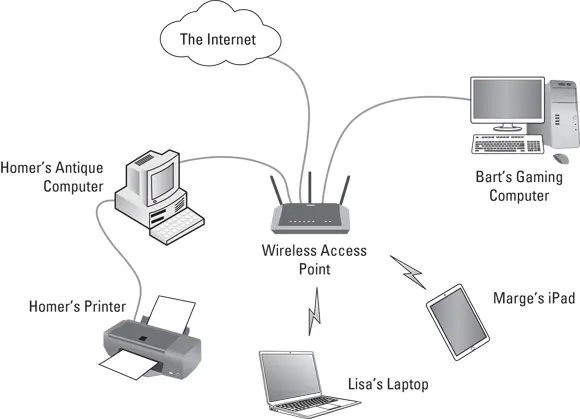Fear not. These bad networks exist only in the dreams of science fiction writers. Real-world networks are much more calm and predictable. Although sophisticated networks do seem to know a lot about you, they don’t think for themselves and they don’t evolve into self-awareness. And although they can gather a sometimes disturbing amount of information about you, they aren’t trying to kill you, even if your name is Sarah Connor.
Now that you’re over your fear of networks, you’re ready to breeze through this chapter. It’s a gentle, even superficial, introduction to computer networks, with a slant toward the concepts that can help you use a computer that’s attached to a network. This chapter goes easy on the details; the detailed and boring stuff comes later.
A network is nothing more than two or more computers connected by a cable or by a wireless radio connection so that they can exchange information.
Of course, computers can exchange information in ways other than networks. Most of us have used what computer nerds call the sneakernet. That’s where you copy a file to a flash drive or other portable storage device and then walk the data over to someone else’s computer. (The term sneakernet is typical of computer nerds’ feeble attempts at humor.)
The whole problem with the sneakernet is that it’s slow, and it wears a trail in your carpet. One day, some penny-pinching computer geeks discovered that connecting computers with cables was cheaper than replacing the carpet every six months. Thus, the modern computer network was born.
You can create a simple computer network by hooking together all the computers in your office with cables and using the computer’s network interface (an electronic circuit that resides inside your computer and has a special jack on the computer’s backside). Then you tweak a few simple settings in the computer’s operating system (OS) software, and voilà! You have a working network. That’s all there is to it.
If you don’t want to mess with cables, you can create a wireless network instead. In a wireless network, the computers use wireless network adapters that communicate via radio signals. All modern laptop computers have built-in wireless network adapters, as do most desktop computers. (If yours doesn’t, you can purchase a separate wireless network adapter that plugs into one of the computer’s USB ports.)
Figure 1-1 shows a typical network with four computers. You can see that all four computers are connected by a network cable to a central network device (in this case, a home router). This component, common in small networks, actually consists of three distinct but related network devices:
Router: Connects your computers to the Internet
Switch: Allows you to connect two or more computers together with cables
Wireless access point: Lets you connect computers and other devices to your network without using cables
In the figure, you can see that two computers — Bart’s gaming computer and Homer’s old 1989 computer — are connected via cables to the switch component of the home router. You can also see that Lisa connects her laptop to the network wirelessly. Marge also connects her iPad to the network wirelessly.
You can also see in the figure that Homer’s computer has a printer attached to it. Because of the network, Bart, Lisa, and Marge can also use this printer.
Finally, you can see that the entire network is connected to the Internet via the router.

FIGURE 1-1:A typical network.
Computer networking has its own strange vocabulary. Although you don’t have to know every esoteric networking term, it helps to be acquainted with a few of the basic buzzwords:
LAN: Networks are often called LANs, short for local area network. In Figure 1-1, the LAN consists of the home router and the computers and iPad that are connected to it directly via cable or wirelessly. LAN is the first TLA — or three-letter acronym — of this book. You don’t really need to remember it or any of the many TLAs that follow. In fact, the only three-letter acronym you need to remember is TLA. You might guess that the acronym for four-letter acronym is FLA. Wrong! A four-letter acronym is an ETLA, which stands for extended three-letter acronym. After all, it just wouldn’t be right if the acronym for four-letter acronym had only three letters.
WAN: The second TLA in this book is WAN. The WAN is part of the network that connects to the Internet. WAN stands for wide area network . Okay, fine. Technically, WAN is the third TLA. The first TLA was LAN, and the second TLA was TLA. So that makes WAN the third TLA.
On the network: Every computer connected to the network is said to be “on the network.” The technical term (which you can forget) for a computer that’s on the network is a node. Another term that’s commonly used to mean the same thing is endpoint.
Online, offline: When a computer is turned on and can access the network, the computer is online. When a computer can’t access the network, it’s offline. A computer can be offline for several reasons. The computer can be turned off, the user may have disabled the network connection, the computer may be broken, the cable that connects it to the network can be unplugged, or a wad of gum can be jammed into the disk drive.
Up, down: When a computer is turned on and working properly, it’s up. When a computer is turned off, broken, or being serviced, it’s down. Turning off a computer is sometimes called taking it down. Turning it back on is sometimes called bringing it up.
Local, remote: A resource such as a disk drive is local if it resides in your computer. It’s remote if it resides in another computer somewhere else on your network.
Internet: The Internet is a huge amalgamation of computer networks strewn about the entire planet. Networking the computers in your home or office so that they can share information with one another and connecting your computer to the worldwide Internet are two separate but related tasks.
Why Bother with a Network?
Frankly, computer networks are a bit of a pain to set up. So why bother? Because the benefits of having a network outweigh the difficulties of setting up one.
You don’t have to be a PhD to understand the benefits of networking. In fact, you learned everything you need to know in kindergarten: Networks are all about sharing. Specifically, networks are about sharing four: files, resources, programs, and messages.
Networks enable you to share information with other computers on the network. Depending on how you set up your network, you can share files with your network friends in several different ways. You can send a file from your computer directly to a friend’s computer by attaching the file to an email message and then mailing it. Or you can let your friend access your computer over the network so that your friend can retrieve the file directly from your hard drive. Yet another method is to copy the file to a disk on another computer and then tell your friend where you put the file so that your friend can retrieve it later. One way or the other, the data travels to your friend’s computer over the network cable and not on a CD or DVD or flash drive, as it would in a sneakernet.
Читать дальше













